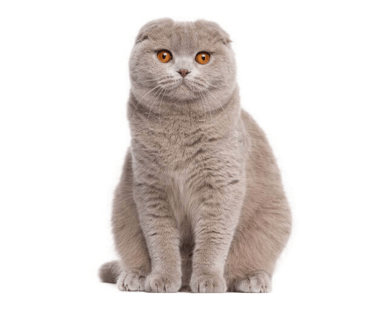Scottish Fold
About the Breed
Who would have thought that one humble Scottish farm cat could become the foundation of one of the cat fancy’s most beguiling breeds? Loving and calm, the Scottish Fold personality is as endearing as its unique look. Without the distraction of upright ears, these cats’ round, soulful eyes are so dominant that they practically overwhelm you with their owl-like charm. The sweet, open expression does the rest; one look, and most people are in love. Even the straight-eared version of this breed—recently elevated to championship status in CFA—is equally appealing. And with long-haired and short-haired cats to choose from, who could ask for more?
Breed History
In 1961, a shepherd named William Ross spotted the first Scottish Fold, a copper-eyed white female named Susie, at a farm in the Tayside region of Scotland. Susie’s folded ears and unique look captured Ross’s heart and he asked for one of her kittens. Susie only produced one litter, so it was actually her daughter Snooks who became the foundation queen. Bred to a domestic male and then to a British Shorthair, she produced folded-ear kittens with both, and established the Scottish Fold as a breed. The folded ears are produced by a dominant gene that is considered a spontaneous mutation. The shorthaired Fold was granted championship status by CFA in 1978. Longhaired Folds achieved the same status in 1992, when the breed was separated into Shorthair and Longhair divisions. Then, in 2022, straight-eared cats were also accepted, so the breed now has four divisions.
GENERAL
The Scottish Fold cat occurred as a spontaneous mutation in farm cats in Scotland. The breed has been established by crosses to British Shorthair and domestic cats in Scotland and England. In America, the outcross is the American and British Shorthair. All bona fide Scottish Fold cats trace their pedigree to Susie, the first fold-ear cat discovered by the founders of the breed, William and Mary Ross. The Scottish Fold cat can be shown with Folded Ears, Straight Ears, and with either longhair or shorthair; in the appropriate class and division.
HEAD
Well rounded with a firm chin and jaw. Muzzle to have well rounded whisker pads. Head should blend into a short neck. Prominent cheeks with a jowly appearance in males.
EYES
Wide open with a sweet expression. Large, well rounded, and separated by a broad nose. Eye color to correspond with coat color. Blue-eyed and odd-eyed are allowed for all white and bi-color and van patterns.
NOSE
Nose to be short with a gentle curve. A brief stop is permitted. Profile is moderate in appearance.
FOLDED EARS
Fold forward and downward. Small, the smaller, tightly folded ear preferred over a loose fold and large ear. The ears should be set in a caplike fashion to expose a rounded cranium. Ear tips to be rounded.
STRAIGHT EAR
Ears to be medium to small with rounded tips. They are set well apart to show a rounded cranium.
BODY
Medium, rounded, and even from shoulder to pelvic girdle. The cat should stand firm with a well padded body. There must be no hint of thickness or lack of mobility in the cat due to short, coarse legs. Toes to be neat and well rounded with five in front and four behind. Overall appearance is that of a well rounded cat with medium bone; fault cats obviously lacking in type. Females may be slightly smaller.
TAIL
Tail should be medium to long but in proportion to the body. Tail should be flexible and tapering which may end in a round tip. Longer, tapering tail preferred.
COAT (SHORTHAIR)
Dense, plush, even. Short to medium-short in length. Soft in texture. Full of life. Standing away from body due to density, not flat or close lying. Coat texture may vary due to color and/or regional/seasonal changes.
COAT (LONGHAIR)
Medium-long to long hair length. Full coat on face and body desirable but short hair permissible on face and legs. Britches, tail plume, toe tufts, and ear furnishings should be clearly visible with a ruff being desirable. Seriously penalize: cottony coat, except in kittens.
PENALIZE
Brow ridge.
DISQUALIFY
Kinked tail. Tail that is foreshortened. Tail that is lacking in flexibility due to abnormally thick vertebrae. Splayed toes, incorrect number of toes. Any evidence of illness or poor health. Palpable nose break.
About the Breed
Who would have thought that one humble Scottish farm cat could become the foundation of one of the cat fancy’s most beguiling breeds? Loving and calm, the Scottish Fold personality is as endearing as its unique look. Without the distraction of upright ears, these cats’ round, soulful eyes are so dominant that they practically overwhelm you with their owl-like charm. The sweet, open expression does the rest; one look, and most people are in love. Even the straight-eared version of this breed—recently elevated to championship status in CFA—is equally appealing. And with long-haired and short-haired cats to choose from, who could ask for more?
Breed History
In 1961, a shepherd named William Ross spotted the first Scottish Fold, a copper-eyed white female named Susie, at a farm in the Tayside region of Scotland. Susie’s folded ears and unique look captured Ross’s heart and he asked for one of her kittens. Susie only produced one litter, so it was actually her daughter Snooks who became the foundation queen. Bred to a domestic male and then to a British Shorthair, she produced folded-ear kittens with both, and established the Scottish Fold as a breed. The folded ears are produced by a dominant gene that is considered a spontaneous mutation. The shorthaired Fold was granted championship status by CFA in 1978. Longhaired Folds achieved the same status in 1992, when the breed was separated into Shorthair and Longhair divisions. Then, in 2022, straight-eared cats were also accepted, so the breed now has four divisions.




